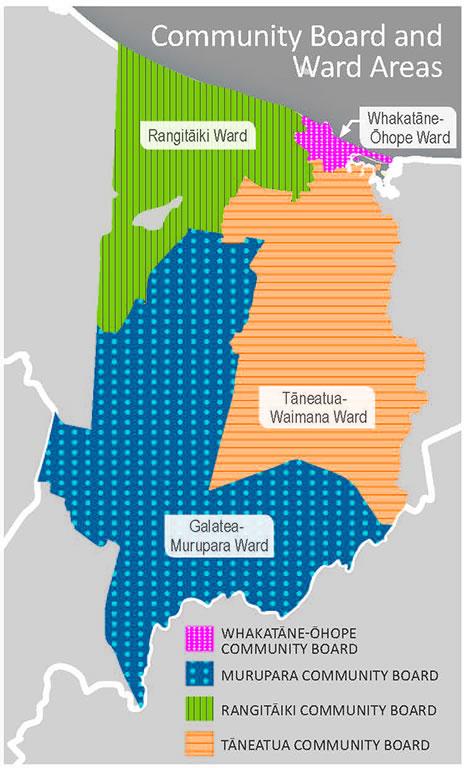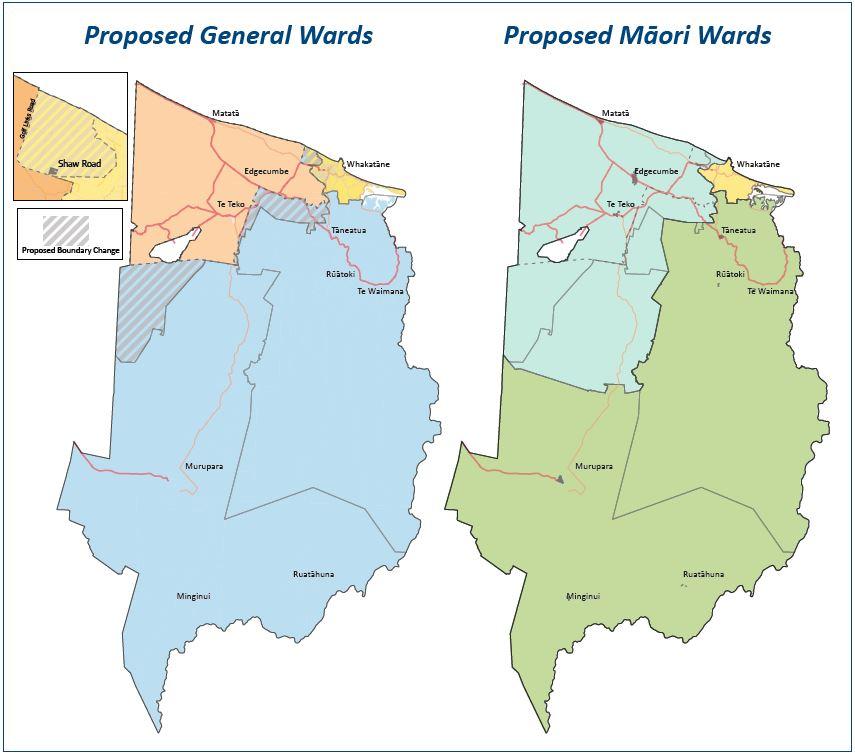We've carried out a process to review how Whakatāne District Council represents our communities.
The representation review was an opportunity to look at the Council structure and the way Councillors are elected.
The review involved deciding:
- the number of Councillors for General and Māori wards.
- whether Councillors are elected from wards or ‘at large’ across the whole district, or a mix of both.
- whether there should be Community Boards, and if so – how many, their names and boundaries and the number of members for each board.
The Mayor and Councillors adopted the final structure for the representation review at a Council meeting held on Thursday, 11 November.
Some changes were made to the initial proposal that went out for consultation, based on feedback received, including:
- Changing the ‘Whakatāne-Ōhope Māori Ward’ name to ‘Kapu te rangi Māori Ward’
- Changing the ‘Tāneatua Communities Board’ name to ‘Tāneatua Community Board’
- Transferring the four meshblocks of the Waiōhau area from the Rangitāiki Māori Ward to the Toi ki uta Māori Ward
- Transferring the one meshblock of the Te Mahoe area from the Te Urewera General Ward to the Rangitāiki General Ward
The next step in the process is for the final proposal to be made available to the public for a one-month appeal period. After that time, any appeals or objections will be forwarded to the Local Government Commission to consider.
Presentation of Whakatāne District Representation Review 2021 - (PPTX, 2.6 MB )
Why did we do this?
He aha mātau i mahi ai i tēnei?
We are required by law (Local Electoral Act 2001) to undertake a representation review at least every six years. The last review was in 2015-16.
In May 2021, Council voted to include Māori wards as part of their representation. This now needs to be included in the overarching representation structure of Council.
- What is the current structure of Council?
He aha te takotoranga whakaahuatanga ināianei? We currently have one Mayor, who is elected 'at large' (district-wide), and 10 Councillors elected from four wards.
The number of Councillors in each ward is dependent on the population of each ward:
- Rangitāiki - three Councillors
- Galatea-Murupara - one Councillor
- Tāneatua-Waimana - one Councillor
- Whakatāne-Ōhope - five Councillors

The Whakatāne District also has four Community Boards, representing each of the wards.
- What is a ward?
He aha te takiwā? A ward is a geographical area outlined by boundaries. A certain number of people in each ward are elected to represent you on Council.
- Explanatory Videos
What is a Representation Review?
Information Council must consider to make a decision
Overview of the Representation Review process
Initial proposal for Council representation structure
You can view a recording of the Extraordinary Council meeting to consider the establishment of Māori Wards on our YouTube channel:
Footage courtesy of TumekeFM.
- Why is the representation review relevant to me?
He aha te arotake whakaahuatanga e hāngai nei ki ahau? It's a review of the Council’s membership to ensure we are providing fair and effective representation to our communities. When we carried out formal consultation in September, our communities were able to help shape what representation for the district looks like going forward.
- Who will this affect?
Mā wai tēnei e whakapā? You! The people you elect are the voice of your community. That voice should represent all people who choose to make the Whakatāne District their home and must represent and balance differing interests.
It is important that you feel you are represented fairly and effectively. If you feel well-represented with the current system, tell us.
- Where and what did the review cover?
Ki hea, he aha hoki tēnei arotake whakaahuatanga? The entire Whakatāne District. This includes all wards and Community Boards, boundaries and subdivisions.
- When will any changes come into effect?
Hei āhea ngā panonitanga e whakatū? An initial proposal was formally consulted on in September 2021. After formal consultation, the final proposal was adopted in November 2021. The updated representation arrangements will take effect for the next local body elections in 2022 and stay in effect for six years.
- How are the ward boundaries and number of elected members decided?
Ka pehea e whakatau ana i ngā rohenga wāri me te tau o ngā mema whai mana pōti? We use population data from 2020 statistics to work out how many people live in different areas of the Whakatāne District. This data informs 'communities of interest', different ward boundary options and how many elected members should represent each area.
- What is the preferred new representation structure?
He aha te Takotoranga Whakaahuatanga e mariu nei? Several options were reviewed, and Council's preferred draft option is to keep the current structure of one Mayor and 10 Councillors, and keep the four current Community Boards.
Here are the key changes within the proposed new structure:
- separate General wards and Māori wards
- seven General ward Councillors and three Māori ward Councillors
- from four General wards to three General wards
- three Māori wards

What about the Community Boards?
The preferred option is to keep the four Community Boards. Each board will be made up of six members and one Councillor. The Community Board boundaries will align with the new General ward boundaries.
- Population data
He raraunga taupori We are required to use the population data from 2020 to re-evaluate the Council structure.
The figures for our district from this census are:
General Wards Population (2020 census) Members Population per member Rangitāiki General Ward 6,900 2 3,450 Whakatāne-Ōhope General Ward 14,900 4 3,725 Te Urewera General Ward 3,310 1 3,310 Total 25,110 7 3,587 Māori Wards Population (2020 census) Members Population per member Rangitāiki Māori Ward 3,920 1 3,920 Whakatāne-Ōhope Māori Ward 4,570 1 4,570 Toi ki uta Maori Ward 4,600 1 4,600 Total 13,090 3 4,363
- What is fair representation?
He aha te whakaahuatanga tika? Fair representation means each elected member represents about the same number of people (within +/- 10 percent).
- Who is an elected member?
Ko wai ngā mema whai mana pōti? A person who is voted for by the community to represent their community.
- What is effective representation?
He aha te whakaahuatanga pai? Effective representation means communities of interest are effectively represented.
- What is a community of interest?
He aha te hapori whaipānga? An area where someone feels a sense of belonging and looks for social, service and economic support. Geographic features and the roading network can affect the sense of belonging to an area.
- Who can become an elected member?
Ko wai ka āhei ki te whai tūranga mana pōti? A candidate standing in either a General or Māori ward must be:
- A New Zealand citizen
- Enrolled as a Parliamentary elector (anywhere in New Zealand)
- Nominated by two electors whose names appear on the electoral roll within the respective area they are standing for. As such, candidates in Māori wards do not have to be of Māori descent
- Candidates cannot stand for General and Māori wards at the same time
- Māori Wards
Ngā Takiwā Māori In May 2021, Council voted to include Māori wards as part of their representation. This now needs to be included in the overarching representation structure of Council.
Māori wards are the local government equivalent of the Māori parliamentary electorates. Electors on the Māori electoral roll will vote for and be represented by candidates contesting a Māori ward, rather than candidates contesting a General ward.
A Councillor elected via a Māori ward represents the entire district in their decision-making.
You can view a recording of the Extraordinary Council meeting to consider the establishment of Māori Wards on our YouTube channel:
Footage courtesy of TumekeFM.
- Do Māori ward elected members only represent Māori?
Ka tū ngā mema whai mana pōti Māori hei māngai noa iho o Ngāi Māori? No. Once elected, all elected members, from General or Māori wards, take a formal oath to represent the entire district.
- Do Māori ward elected members only represent their iwi?
Ka tū ngā mema whai mana pōti Māori hei māngai noa iho o tō rātou ake iwi? No. The Māori ward elected members could whakapapa to particular iwi, but under the formal oath they will represent all community members.
- Who can be on the Māori electoral roll?
Ko wai ka āhei ki te noho i te rārangi pōti Māori? If you're of Māori descent, you can enrol in either the General or Māori electoral rolls. If you're not of Māori descent, you can only enrol in the General electoral roll.
